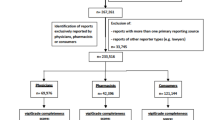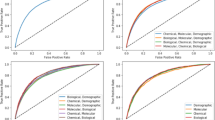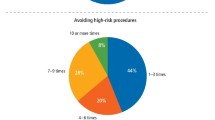Key Points
-
Explores the perceptions and attitudes of dental students and practising dentists towards identifying and reporting suspected adverse drug reactions via the yellow card scheme.
-
Provides an impression of the level of pharmacovigilance knowledge and a training needs analysis.
Abstract
Objective To assess the level of knowledge and reporting of adverse drug reactions (ADRs) of dentists at different stages of their careers and conduct a training need analysis.
Design Structured questionnaires were distributed to final year dental students (DSs), foundation year one students (DF1s) and general dental practitioners (GDPs).
Setting Opportunity samples of DSs from Kings College London, DF1s from the postgraduate deaneries of Kent, Surrey and Sussex, and Oxford and GDPs in Hampshire and the Isle of Wight. The study was conducted from November 2012 to February 2013.
Main outcome measures Relative knowledge and awareness of ADRs and ADR reporting, and performance in an assessment of these aspects.
Results Thirty-one DSs, 35 DF1s and 98 GDPs took part in the study. Awareness of the Yellow Card Scheme varied between groups (30.8%, 48.6% and 88.8% respectively). Reported use of the scheme was uniformly low (2.6%, 5.7% and 5.1% respectively). There were no differences in knowledge about ADRs and ADR reporting between the three groups of dentists as indicated by median scores achieved in the questionnaire test (54%, 73% and 62% for DSs, DF1s and GDPs respectively; p = 0.638). All of the DSs, 91.4% of DF1s and 91.8% of GDPs said that they would welcome further training. Key topics included training on ADRs to medicines commonly used in their dental practice and deciding what ADRs needed to be reported. The most popular format for delivery of this training was formal lectures for DF1s and GDPs, but workshops for DSs. Postgraduate deaneries were the most popular provider choice for DF1s and GDPs.
Conclusions Dentists at different stages of their careers showed variable awareness and knowledge of the UK Yellow Card Scheme and what to report. Training should be tailored to fit the needs of the different groups. A questionnaire survey incorporating a summative knowledge assessment demonstrated variable levels of knowledge about adverse drug reactions and what to report. Large majorities of all groups (>90%) expressed a desire for training in these areas and in the case of graduate and practising dentists, indicated that this should be organised by the postgraduate deaneries.
Similar content being viewed by others
Log in or create a free account to read this content
Gain free access to this article, as well as selected content from this journal and more on nature.com
or
References
Medicines and Healthcare products Regulatory Agency. Medicines Act 1968 Advisory Bodies annual report 2010. London: MHRA, 2011.
Metters J . Report of an independent review of access to the yellow card scheme. London: The Stationery Office, 2004. Online report Available at http://www.mhra.gov.uk/home/groups/comms-ic/documents/websiteresources/con2015008.pdf (accessed March 2014).
Medicines and Healthcare products Regulatory Agency. MHRA annual statistics 2011/12. London: MHRA, 2012.
Cowen J . Personal communication, MHRA, 281/2013.
Yip J, Radford D R, Brown D . How do UK dentists deal with adverse drug reaction reporting? Br Dent J 2013; 214: E21.
Cox A R, Marriott J F, Wilson K A, Ferner R E . Adverse drug reaction teaching in UK undergraduate medical and pharmacy programmes. J Clin Pharm Ther 2004; 29: 31–35.
Carnelio S, Khan S, Rodrigues G . Pharmacovigilance in clinical dentistry: overlooked or axiomatic? General Dentistry 2011; 59: 24–30.
Stewart D, MacLure K, Paudval V, Hughes C, Courtenay M, McLay J . Non-medical prescribers and pharmacovigilance participation, competence and future needs. Int J Clin Pharm 2013; 35: 268–274.
Medicines and Healthcare products Regulatory Agency. Guideline on communication of risks and benefits in patient information leaflets. London: MHRA, 2005.
European Medicines Agency. Annex 1: summary of product characteristics. Online report available at http://www.ema.europa.eu/docs/en_GB/document_library/Template_or_form/2009/10/WC500004368.pdf (accessed March 2014).
European Medicines Agency. Information on benefit–risk of medicines: patients', consumers' and healthcare professionals' expectations. London: EMEA, 2009. Online report available at http://www.ema.europa.eu/docs/en_GB/document_library/Other/2009/12/WC500018433.pdf (accessed July 2013).
Cox A R, Butt T F . Adverse drug reactions: when the risk becomes a reality for patients. Drug Saf 2012; 25: 977–981.
Pemberton M N, Gibson J . Chlorhexidine and hypersensitivity reactions in dentistry. Br Dent J 2012; 213: 547–550.
Chlorhexidine digluconate mouthwash. Online product information available at https://www.medicines.org.uk/emc/medicine/21647 (accessed July 2014)
Janssen Cilag Ltd. Daktarin oral gel - undesirable effects. Online information available at http://www.medicines.org.uk/emc/medicine/7301/SPC/Daktarin+Oral+Gel/#UNDESIRABLE_EFFECTS (accessed March 2014).
Medicines and Healthcare products Regulatory Agency. The yellow card scheme. Online information available at http://www.mhra.gov.uk/Safetyinformation/Reportingsafetyproblems/Reportingsuspectedadversedrugreactions/informationforhealthcareprofessionals/Adversedrugreactions/index.htm#1 (accessed March 2014).
Accord Healthcare Ltd. Amlodipine 10 mg tablets. Online information available http://www.medicines.org.uk/emc/medicine/25861/SPC/Amlodipine+10+mg+tablets/#UNDESIRABLE_EFFECTS (accessed March 2014).
Medicines and Healthcare products Regulatory Agency. Black Triangle Scheme - new medicines and vaccines now subject to EU-wide additional monitoring. London: MHRA, 2013. http://www.mhra.gov.uk/NewsCentre/CON321806 (accessed March 2014).
Taylor J, Pemberton M N . Yellow card scheme. Br Dent J 2013; 215: 59.
Posadzk P, Watson L K, Alotaibi A, Ernst E . Prevalence of herbal medicine use by UK patients/consumers: a systematic review of surveys. Focus on Alternative and Complementary Therapies 2013; 18: 19–26.
Health Foundation. Evidence scan: quality improvement training for healthcare professionals. Health Foundation, 2012. Online report available at http://www.health.org.uk/public/cms/75/76/313/3731/Quality%20improvement%20training%20for%20healthcare%20professionals.pdf?realName=XZlZmh.pdf (accessed August 2014).
Boud D J . Problem based learning in perspective. In Boud D J (ed), Problem based learning for the professions. pp 13–18. Sydney: Higher Education and Research Development Society of Australia, 1985.
Wood D F . Problem based learning. Br Med J 2003; 326: 328–330.
Koh G G H, Khooh H E, Wong M L, Koh D . The effects of problem-based learning on physician competency: a systematic review. Can Med Assoc J 2008; 178: 34–41.
Reeves J, Francis S A . A comparison between two methods of teaching hospital pharmacists about adverse drug reactions: problem-based learning versus a didactic lecture. Pharmacy Education 2000; 1: 25–25.
Pulford A . Malcolm W . Knowledge and attitudes to reporting adverse drug reactions. Br J Nursing 2010; 19: 899–904.
Medicines and Healthcare products Regulatory Agency. Pharmacovigilance learning module: adverse drug reactions. Online information available at http://www.mhra.gov.uk/ConferencesLearningCentre/LearningCentre/Medicineslearningmodules/Pharmacovigilancelearningmodule/pharmacovigilancelearningmodule/adversedrugreactions/index.htm (March 2014).
Medicines and Healthcare products Regulatory Agency. Drug safety updates. Online updates available at http://www.mhra.gov.uk/Publications/Safetyguidance/DrugSafetyUpdate/index.htm (accessed March 2014).
Medicines and Healthcare products Regulatory Agency. MHRA opens new Twitter channels. London: MHRA, 2013. Online article available at http://www.mhra.gov.uk/NewsCentre/CON226970 (accessed March 2014).
Smith M P, Webley S D . Pharmacovigilance teaching in UK undergraduate pharmacy programmes. Pharmacoepidemiol Drug Saf 2012; 22: 223–228.
Medicines and Healthcare Products Regulatory Agency. Medicines watchdog launches campaign to urge pharmacists, GPs and the public to report side-effects through vital drug safety warning system. London: MHRA, 2013. Online press release available at http://www.mhra.gov.uk/NewsCentre/Pressreleases/CON231524 (accessed March 2014).
New medicine service boosts yellow card reports. United Kingdom: NHS Employers, 2012. Online article available at http://www.nhsemployers.org/PayAndContracts/CommunityPharmacyContract/CommunityPharmacyLatestNews/Pages/New-medicine-service-boosts-yellow-card-reports.aspx (accessed March 2014).
Acknowledgements
The authors would like to thank Dr Christine Cheshire, Dental Academy Tutor and Dr Jeyanthi John, Consultant for Dental Public Health for their valuable reviews of the questionnaires and methodology; and Mr Mitulsinh Jadeja, MHRA Vigilance and Risk Management of Medicines Division, for manuscript review and helpful comments.
Author information
Authors and Affiliations
Corresponding author
Rights and permissions
About this article
Cite this article
Patel, M., Radford, D. & Brown, D. Preaching to the converted – optimising adverse drug reaction reporting by dentists. Br Dent J 217, E4 (2014). https://doi.org/10.1038/sj.bdj.2014.598
Accepted:
Published:
Issue date:
DOI: https://doi.org/10.1038/sj.bdj.2014.598



